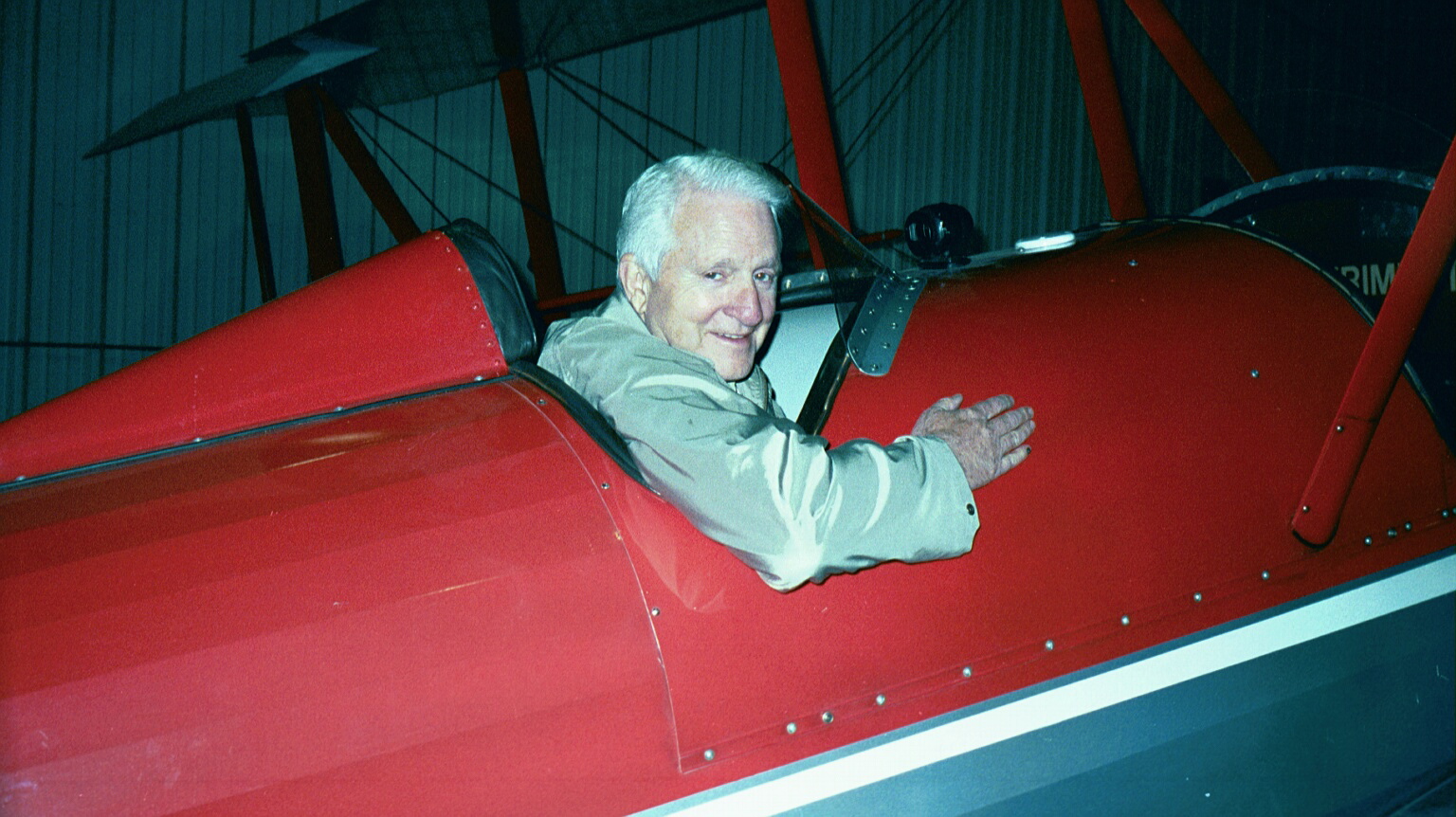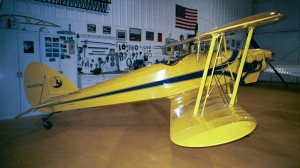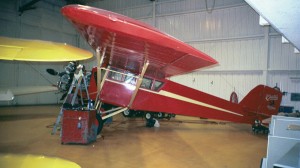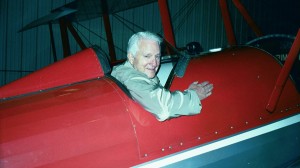 Carl Williams’ father once sold 30 heads of steer to purchase an Alexander Eaglerock, like this one owned by Williams. This 1929 Eaglerock, which Williams restored, is the second one he’s owned.
Carl Williams’ father once sold 30 heads of steer to purchase an Alexander Eaglerock, like this one owned by Williams. This 1929 Eaglerock, which Williams restored, is the second one he’s owned.
By Di Freeze
When visionaries embarked upon their journey to establish the City of Centennial, they mentioned it to cable pioneer and philanthropist Carl M Williams. He immediately wrote a check for $10,000. It wasn’t the first time Williams had been that generous, and it wouldn’t be the last.
In his office at Carl M. Williams & Associates, Inc., at the Denver Tech Center, pictures and models of aircraft, as well as other reminders of his rich history surround Williams. Although he has a busy day ahead of him, he takes time to talk about some of his favorite subjects: aviation, family, ranching and the cable industry.
During the conversation, Williams fondly pulls out a newspaper titled The Williams Journal. He explains that 10 years ago, for his brother Jim’s 70th birthday, he commissioned someone to dig through 100 years of news items in the local paper in Douglas, Wyo., and collect everything ever written about the Williams family. On the cover of the paper is the family tree. On the second page is a picture of John Torrence Williams.
“Johnny, you’ve been gone a year out there in the West, and we’re worried,” reads an excerpt from a letter written in 1879 that is included in the article. “Sally is still waiting here, and wouldn’t it be better if you came back?”
But John T. Williams never returned to Wisconsin. He became a ranch foreman in central Wyoming, established his own livestock outfit, became a partner in a general merchandise store, and eventually, became the first elected sheriff of Converse County and a Wyoming senator. He also married the former Lizzie Ragsdale and had three children. One of those children, John Walter “Mike” Williams, married Eleanor Powers and had four sons, John Walter Jr., Frank, James and Carl Michael.
Carl Williams, the youngest sibling, born on Nov. 9, 1928, laughs as he tells a story involving his grandfather and a posse that went in search of a bandit in the late 1890s. With several other thieves, the man had raided a sheep camp. Great-Uncle Abner fired a warning shot, and then shot the horse out from under the bandit, who refused to halt. As the man fled on foot, Abner fired again.
“My God, Ab, don’t shoot! I’m a man with a family!” Williams mimics the bandit, as he tells the oft-repeated story.
He proudly points to pictures of his ancestors, and talks fondly of his brothers, including Frank, who flunked out of naval aviation as a cadet during WWII but got his pilot’s license 50 years later.
Through the newspaper, the proud heritage of the Williams family unravels. His earliest recollections are of the 33,000-acre ranch in Douglas, where he grew up. His grandfather eventually passed on the job of running the ranch to Williams’ father. He in turn intended to one day leave the ranch to one of his offspring.
“I really enjoyed it,” says Williams of his life as a third-generation rancher. “I liked the whole idea of being out there and thinking about everything on the ranch and knowing my neighbors.” The entrepreneur remembers that even as a child he approached his neighbors to see if they wanted to sell.
“Think and Grow Rich”
During World War I, Williams’ father served as an ensign on board a destroyer off the East Coast. During the years after that war, John Walter Sr., who was in the naval reserve, turned over the job of running the ranch to his children.
In 1941, John Walter Jr., known as Jack, entered WWII. Carl Williams, now 13, attended school regularly, but like other children in the ranching community during the war years, was released in early spring to attend to the family ranch. As the only male left at home, the entire burden of running the ranch rested on his young shoulders.
In between school and working the ranch, Williams, who dreamed of one day owning his own business (or several), was busy reading “Think and Grow Rich,” by Napoleon Hill. He devoured the book word for word.
Also at that time, he was introduced to his first airplane ride. Shortly before he was born, his father had become a pilot; he sold 30 heads of steer to purchase an OX-5 long-wing Alexander Eaglerock. Although he had quit flying after the aircraft crashed into a livestock barn at the state fair in 1927, he was willing to arrange for his son, who had only seen pictures of the Eaglerock, to have his first ride in a Cessna 120 out of Cheyenne Municipal Airport in 1941. Williams loved it.
Tragic news
In 1942, his family received the tragic news that Jack Williams had burned to death in a barrack’s fire in Corvallis, Ore., while trying to give assistance to soldiers trapped inside. Following the death of his son, John Walter Sr. entered war for the second time. He entered with a lieutenant’s senior rating, and was assigned to the staff of the adjutant general in Cheyenne, Wyo.
Soon after enlisting, he convinced his commander to return him to sea duty, and he was stationed in Monterey, Calif. The family packed their bags, leased the farm out, and left for California. Because of this, Carl Williams would attend several different schools during his high school years.
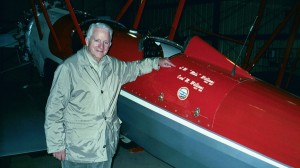
Carl Williams’ second Eaglerock bears the words J.W. “Mike” Williams, Pilot, 1927 (a dedication to his father) and Carl Michael Williams, Pilot, 1992.
As a sophomore, he made many visits to the air base and had the opportunity to sit in the cockpit of the combat planes and fantasize. Life’s choices were starting to get complicated: rancher, businessman, fighter pilot? He wanted to do it all, but at that age, didn’t think it was possible.
“At 13 or 14, you don’t know what you want to—or can—do,” says Williams.
By the time he was 15, he knew he wanted to go into business, and he knew he wanted to make money, but he still wasn’t sure what venue he wanted to take. Then there was the fact that he still had his youthful years ahead of him. There were football games to play, rodeos and country dances to attend, and the occasional brawl to participate in.
In the fall of 1946, Williams began attending the University of Wyoming. He majored in statistics, a subject that caused his imagination to run away with him because “there was power in statistics.” Although his father suffered a stroke in early 1947, Williams was able to continue attending college. He also continued to run the ranch, since his brothers were involved elsewhere.
It was then that he made a life-changing decision. When his father asked him if he wanted the ranch, he had to think hard.
“I had been at the university for less than a year, and my eyes were wide open,” he said. “I always wanted to be on the ranch, but when I made the decision, I decided against it. It was a bad decision. Knowing what I know about myself now, I could have handled the ranch and done everything else.” (The ranch was later sold.)
With the decision made, Williams continued to attend the University of Wyoming until he transferred to the University of North Carolina in 1949, because of its exceptional applied statistics course. He earned his bachelor’s degree in economics (with a focus on statistics) in 1950. But his life was about to take another turn.
The Wyoming Air National Guard
On June 25, 1950, the Korean War broke out. Like his father and his brother before him, Williams wanted to enter the service, but he knew that on-going nasal problems, which resulted in problems with his ears, would probably keep him out of the service. After his parents consented to it, and without taking time to participate in his graduation ceremonies, he was admitted to Duke University Hospital, where he underwent a series of operations that would clear up the problems, and qualify him for a flight physical. Williams would always remember his ride home from the hospital.
“I’ve never had such luxury since,” he said of his ride home in a private train compartment.
When he arrived back in Wyoming, he got the only “job” that he would ever hold in his life (besides his position in the services, which he says might qualify as a “job”).
“The only paycheck I ever got in my life was working for the State of Wyoming in the Employment Security Commission,” says Williams. As the unemployed came in to get their applications, he would interview them to see if they were qualified for benefits.
Although his father’s health was still poor, he made the trip with his son to Cheyenne to inquire into entering the Navy or the Air Force. It was the adjutant general, a family friend, who suggested that Williams, like his Uncle Carl before him, consider joining the Wyoming Air National Guard and getting his pilot’s training that way. Williams took the advice and joined the Guard in the fall of 1950; his two years in ROTC qualified him instantly qualified as a “two-striper.”
His weekends were spent in drill practice. Williams was also given the task of maintaining an F-51 Mustang, a job which included the thrill of running up the beautiful plane. During training, he was simultaneously able to continue his education.
In February 1951, Williams’ unit was called to active duty. He entered the U. S. Air Force, and trained at Goodfellow Air Force Base, San Antonio, Texas, in a North American AT-6 Texan, soloing in Sept. 1951. During pilot training, he would take two emergency leaves due to the health of his father, who passed away in October 1951.
After training, Williams’ class, 52-D, went on to advanced training at Williams Air Force Base, where he qualified in the F-80, a single-engine fighter jet. His first assignment would be in an F-51 Mustang squadron.
“We transitioned from a jet, where you don’t need rudders, to an F-51, where it’s all rudders,” said Williams. “We did some pretty wild checkouts!” Before long, they were once again assigned to F-80s. Williams also flew the C-47, C-45 and T-33.
He was released from active duty near the end of the war in 1952, but remained a captain in the Air National Guard Active Reserve until 1958.
Hanging out his own shingle, politics and cable
As for his career, Williams had decided that statistics wasn’t his “cup of tea.” When asked what one does with statistics, Williams answered, “Not a damn thing!”
In the fall of 1953, he reentered the University of Wyoming and earned his doctor of jurisprudence in 1956. He was about to go into practice with an oil company when a professor, George Rudolph, offered him advice that would again work in his favor. He told him to start his own practice, because “the guys that make the most money are the ones that go out and hang their own shingle.”
“That turned me on my heel, and I will always be grateful for that word of advice,” said Williams. He hung out his shingle, making a deal with a premier oil company to trade office space for law services.
Williams’ father had once run unsuccessfully for the House of Representatives and gravitated to Cheyenne during legislative gatherings. As for Carl Williams, he’d been interested in politics since he attended a political rally with his family in the 1930s. During the 1957 session of the Wyoming legislature, he returned to Cheyenne to become the attorney for the Wyoming House of Representatives. While in Wyoming, in the late spring, a friend of Williams, Bob Laidlaw, approached him to represent him in the acquisition of a community antennae television system in Thermopolis, Wyo.
Williams laughs and says he didn’t have the slightest idea then what a community antennae television was. Williams agreed to take the case, and set about finding out all he could about the industry. His search for knowledge brought him to the office of cable pioneer Bill Daniels and his colleague Gene Schneider.
Williams’ unannounced visit produced an engineer (Schneider’s brother Richard) who journeyed with him to Thermopolis, charging $25 for a day’s work of consulting. The deal fell through for Williams’ client, but Williams became interested in the system. However, other “old-timers” in the cable industry beat both of them to it. (In later years, Williams and TCI cable giant Bob Magness would buy the company.)
At that time, there were 300,000 cable subscribers throughout the United States. In mid-summer of 1957, Daniels invited Williams to join him in founding a new cable television company in Denver, with the intent of pursuing “pay television.”
“He offered me $700 a month, and I bargained with him,” says Williams, who started with the company as general counsel. He told Daniels he would take $500 a month, if he could receive a “little equity” in the company.
When Williams arrived in Denver in September, he was surprised to find that TelEvents, Inc., consisted of little more than a balance sheet, and had little money. Daniels had a small office at Broadway and 17th Street, and Williams temporarily set up his office in the Shirley Seboy Hotel, until the main office could be expanded. He began the work of incorporating the company, and putting together presentations to make applications for pay television franchises before city councils. There was also the little matter of finding funding, which eventually came through a loan from United Bank.
At that time, pay television, due to beginning technology, meant one channel. The company applied in every major city in the Rocky Mountain area south of Great Falls, Mont., and north of Albuquerque, N.M. They were shooting for 30,000 subscribers.
That fall, the first U.S. experiment to turn a cable system into pay television failed in Bartlesville, Okla. Williams quit flying for the Guard to travel and make a concentrated effort on earning television franchises. Televents fared poorly as well; the company earned one franchise, in Aurora, Colo., by the end of that year. The nation’s market and technology weren’t yet ready for pay television.
In 1958, Daniels and Williams decided to shift their interest from pay television and purchased a closed circuit distribution system in Mile City, Mont., with the hopes of converting it to cable. They ran into trouble with the company when the Federal Communications Commission, which had developed new policies to protect television stations, wouldn’t allow them to put in or build their own microwave system; the Mile City system closed later that year.
Ironically, the new policy came out of a costly lawsuit filed between the television system station in Thermopolis, Wyo., and the cable system that Williams had once tried to purchase. The lawsuit went all of the way to the Supreme Court.
That same year, Daniels decided to form Daniels & Associates, a cable television brokerage firm, with Williams once again his partner in the venture. Daniels put in $600 for 60 percent of the business and Williams put in $400 for 40 percent. A month later, Daniels sold 10 percent to another partner, Winston Cox, for $500, making Daniels initial cost basis $100.
Daniels had been the president of the National Cable Television Association and had a myriad of contacts in the industry. He knew that there were brokerages for television, radios and newspapers, but no brokerage companies specializing in cable television.
The successful venture began when a friend of Daniels agreed to allow them to list three of his cable systems in Western Pennsylvania and Southwest New York. Williams did the analysis on the companies, making out forms listing details and climbing poles and towers, and Daniels listed them.
By the early 1960s, Daniels & Associates had built a strong management team that operated 28 cable systems in 16 states. From 1959 through 1963, Williams traveled throughout the U.S., checking out systems and dealing with clients, appraising and conducting inventories.
“The further I went, the more I learned about the business,” says Williams. “I learned what people were doing right and wrong and became an expert.”
In most cases, the company found buyers new to the industry, and then took a minority position in the company, running it for them. Their system, which included 100,000 subscribers, became the first and largest system in the country run by one management, with a computerized, centralized billing system.
In 1963, the two men divided their interests—and debts. Once again, Williams was on his own.
“I always considered I was on my own anyway,” says Williams. “That wasn’t a job either. If we didn’t make money, I didn’t get paid.”
Daniels took sole ownership of Daniels & Associates and Williams became sole owner and president and CEO of Televents. Williams turned his interests towards pursuing the building, developing and operating of their various cable television systems. The company eventually expanded into California, Wyoming and Florida.
Senator Williams
In 1968, Williams was elected to a four-year term in the Colorado State Senate. After declining to run for a second term as senator, he was elected Republican state chairman of Colorado in 1975, and was elected to the Republican National Committee, serving until 1977. His political career includes serving as a delegate to the Republican National Convention in 1980, and serving as chairman of the Senate State Affairs Committee. He founded and was chairman of the Foundation for Drug Education Inc., a program that was created to apprize state legislators and local leaders of new developments in the fight against illegal drugs.
Williams sold Televents to Tele-Communications, Inc. (TCI) in late 1986. Over the years, his presence in the cable industry included being on the board of directors of the National Cable Television Association, and on the steering committee of the Cable Television Satellite Entity, which was formed to encourage first satellite delivery to cable television systems. He was also on the board of directors of the Colorado Cable Television Association, Legislative Committee, and on the board of directors of American Cable Publishers Institute. He was inducted as a cable pioneer into the National Cable Television Center’s Hall of Fame in 1969, and joined the board of directors of the National Cable Television Center and Museum in March 1998.
Selling his company left him time for many passions and interests. He served on the board of directors of the Auraria Higher Education Center, the Mountain States Legal Foundation and the Rocky Mountain Arthritis Foundation. He was a volunteer for the Denver Juvenile Court and was a member of the Governing Council of Denver Community Colleges. He was a vestryman for the Ascension Episcopal Church and served as president while on the board of directors of the University of Wyoming Foundation. He also had a seat on the executive board of the Denver Area Council of the Boy Scouts of America.
In his “free time,” he continued to read, ski, scuba dive, and fly, buy and restore aircraft. Williams purchased his first plane in the mid-1960s. He flew his Cessna 210 until the engine “quit on him.” After that, he went through a Piper Aztec, Piper Navajo, a Baron, a P-Navajo, a Cheyenne I and II, a C-210, a C-182, a Citabria and a Maule. In 1987, he purchased and restored his own Alexander Eaglerock, which was built in 1930 in Colorado Springs. After flying it for several years, he donated it to the City & County of Denver in 1993, through the Colorado Aviation Historical Society. It’s now proudly displayed at Denver International Airport, near Gate 22B. He also turned his attention to sport aviation, and became involved in aerobatics competition, piloting a Pitts Special S2B biplane.
Today, Williams owns four aircraft, including a Beechcraft F-33A Bonanza, a 1929 Curtiss Robin, and a 1994 plans-built aerobatic sport biplane Skoyte. His second Eaglerock (1929), which he also restored, bears the words J. W. “Mike” Williams, Pilot, 1927, and Carl Michael Williams, Pilot, 1992. He houses these at a hangar at Centennial Airport. He also has half interest in a Citation.
Williams is a familiar figure at the airport, where he’s often seen in the company of his two black, standard poodles. Although he no longer participates in aerobatic competitions, he still flies, and maintains commercial, multi-engine, single engine and instrument ratings. His total flying time to date is just under 4,000 hours.
Recently, Williams completed a stint as chairman of the board for Wings Over the Rockies Air and Space Museum, Colorado’s premier aviation museum, which is housed at the former Lowry Air Force Base. While chairman, Williams’ desire was to get young people involved in aviation.
In 1999, under Williams’ direction, the museum was named one of only four museums in the U.S. to partner with the Experimental Aircraft Association in their science, math and technology leadership program. The facility also helps Boy and Girl Scouts earn aviation merit badges, and its Fantasy of Flight program lets kids experience how aircraft actually fly. The museum was also selected as one of several Challenger Learning Centers nationwide.
Williams also spearheaded fundraising efforts for a hands-on Challenger Learning Center in another Lowry hangar adjacent to the museum and led the competitive effort to acquire the Fighter Museum in Mesa, Ariz., and move that collection to Denver. Along with donations to various aviation museums, the philanthropist has been an active pilot for Airlifeline, an organization that transports important medical cases to treatment centers located at great distances from Denver. He’s a member of the board of directors of the U. S. Aerobatic Foundation, the President’s Council of the Experimental Aircraft Association, and the advisory committee to the Centennial Airport Authority, which was formed to assist in long-term bond management related to airport improvements. He served as vice president of the Jack Swigert Memorial Commission (Apollo XIII), which was appointed by the president of the Senate to acquire and fund a statue for permanent placement in the U.S. Capital in Washington, D.C.
Williams was inducted into the Colorado Aviation Hall of Fame in 1997. He lives with his wife of three and one half years, the former Lisa Peterson Wait, in Cherry Hills Village, with Lisa’s two children, Jacque, 16, and Bryan, 13.
An earlier marriage produced two children. Eleanor Payne Hopkins lives in Denver with her husband, Lynn, a CPA. Michael Carl Williams lives in Los Angeles and founded an international general trading company. Both children are graduates from the University of Denver, where Williams is a member of the board of trust. His daughter has a bachelor’s degree and his son recently received his doctor of jurisprudence.
Williams has made generous contributions to D.U., including a $1.5 million grant he contributed for a new 65-bell, five-and-one-half octave carillon known as the Williams Carillon, which is installed in the 215-foot Williams Tower of the Daniel L. Ritchie Center for Sports & Wellness. The tower, faced with Hansen sandstone and Indiana limestone, is one of Colorado’s tallest and finest. Due to one generous endowment gift from Williams, in 1998, D.U. established the Carl M. Williams Institute for Ethics and Values, taking the institute’s original interest in ethics and values and expanding it’s scope, programming, scholarly endeavors and public outreach. He’ made generous donations to the Arthritis Society, which presented him with a Humanitarian Award.
Sometimes Williams exercises his generosity when he doesn’t even mean to. In May 2000, Penny Parker, a local columnist, noted that “the really rich guy Carl Williams learned an expensive lesson during the live auction at the Mask Project Gala in the Cherry Creek mall.” Williams, who co-chaired the benefit being held there for the Hospice of Metro Denver with his wife, happened to wave at the wrong time to one of his acquaintances. $21,000 dollars later, Williams and his wife became the proud owners of a mask sculpture created by artist David Hoffman.
“Don’t worry, they can afford it,” said Parker of the couple. Not only can Williams afford it, I’m sure he was happy to donate the money.
Although Williams did indeed “think” and “grow rich,” he’s well aware that making money isn’t the most important thing in life. But he believes that it’s a way to “buy freedom”—freedom to participate in his passions, and freedom to give of his time and money.











